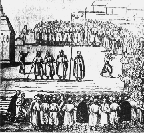 Zaporizhia
Zaporizhia Zaporizhia
Zaporizhia
Zaporizhia [also Zaporizhzhya]. The name of the military and political organization of the Ukrainian Kozaks and of their autonomous territory (approx. 80,000 sq. km.) in southern Ukraine from the mid 16th century to 1775. The name was derived from the territory's location 'beyond the [Dnipro] Rapids' (za porohamy). Its center was the Zaporozhian Sich. Zaporizhia's territory - the 'Liberties of the [Kozak] Host beyond the [Dnipro] Rapids' - was situated to the south and east of Polish-ruled Right-Bank Ukraine, from which it was separated by the Boh River, its tributaries the Synyukha and the Velykyj Vys, and the Tyasmyn River, a tributary of the Dnipro. To the northeast it bordered on the Left-Bank Hetman state along the Dnipro River and its tributary, the Orel. To the east it was separated from Russian-ruled Slobidska Ukraine by the Donets River. To the southeast it bordered on the lands of the Don Kozaks [Donski Kozaky] along the Kalmiyus River. Zaporizhia extended southward deep into the steppe, where it bordered on the Crimean Khanate and reached, between the Berda and Kalmiyus rivers, the Sea of Azov.
The Kozaks gained renown in the late 15th century as defenders of the Lithuanian-Ruthenian state against the Crimean Tatars, while the Cherkasy and Kaniv starosty [mea culpa, material missing, will be fixed soon 5.III.99] and living as free brigands in the uncolonized steppe frontier of the Polish state. The rise of Zaporizhia resulted from the increasing colonization of that frontier by Ukrainians fleeing serfdom and other Polish-Lithuanian oppression. There they established homesteads and, to defend themselves from Tatar raids, built fortified camps (sichi), which were later united to create a central fortress, the Zaporizhian Sich, under the leadership of Prince Dmytro (Bajda) Vyshnevetskyj on the island of Mala Khortytsya (ca. 1552). The anti-Polish Kozak rebellions of the 1590's, 1620's, and 1630's originated in Zaporizhia and resulted in the growth of the military and political strength of the Zaporozhian Host.
By the late 17th century a unique sociopolitical order had evolved in Zaporizhia; with certain changes, it existed until the end of the 18th century. The order based on the political equality of all Zaporozhian Kozaks regardless of their social origins. The principle of general elections was applied to all representative bodies, including the supreme Sich Council, the central administrative body, known as the Kish of the Zaporozhian Sich, the koshovyj otaman and his starshyna, and the kurins. Those elected figures constituted the Council of Officers, a collegial administrative body. Outside the Sich appointed colonels commanded districts called palanky (8 in the 18th century).
At the Sich the Zaporozhian Host was traditionally divided into 38 kurins (the number of kurins was actually higher, because several existed outside the Sich), each with several hundred Kozaks. Numerous homesteads (zymivky) on the territory of each palanka were inhabited by married Kozaks (since only unmarried Kozaks could dwell at the Sich) and peasants, who engaged in individual farming. Collective farming was undertaken by each kurin. Fishing, hunting, and cattle raising were the chief occupations in Zaporizhia. Zaporizhia also played an important commercial role because of its location on the trade route from Crimea to Poland, the Hetman state, and Muscovy.
 Kozak Links |
